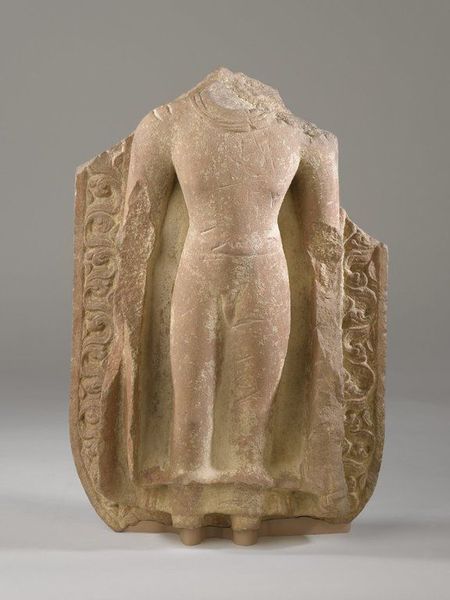Rubin Museum traces spread of stylistic and visual elements of religious iconography across asia
Standing Bodhisattva, Northern China, Jin Dynasty, 1115 - 1234. Wood, traces of polychrome. Brooklyn Museum, Brooklyn Museum Collection, 37.223.
NEW YORK, NY.- The Rubin Museum of Art presents From India East: Sculpture of Devotion from the Brooklyn Museum, an exhibition tracing the stylistic evolution of Hindu and Buddhist sculptural artworks across Asia from the 2nd and 3rd centuries BCE through the 18th century CE. The exhibition provides audiences with one of the most comprehensive comparative overviews of religious iconography in sculptural form, which was shaped by geographic location, time period, and cultural idioms as it spread from India to Sri Lanka, Tibet, Nepal, Burma (present-day Myanmar), Korea, Japan, and most Southeast Asian countries. The forty-eight works featured in From India East were selected from the Brooklyn Museum’s extensive collection as the best examples of this iconographic diaspora. The Rubin’s immersive environment, dedicated to the cultures and art of Himalayan Asia, is the first to provide this context to the Brooklyn Museum’s collection. The exhibition is on view at the Rubin through July 7, 2014.
“From India East gives us an opportunity to show classical masterworks from another perspective,” said Jan Van Alphen, Director of Exhibitions, Collections, and Research at the Rubin Museum. “The works from the Brooklyn Museum expand the context of our collection beyond Himalayan Asia, and by coming together in our focused space, the works themselves are able to tell stories that delve more deeply and broadly into the geography, culture, nationality, and artistic practices of places across Asia.”
From India East includes religious sculptures in a range of mediums including terracotta, stone, bronze, and wood and is organized in sections that trace the spread of Hinduism and Buddhism across regions. Examples of lineages that highlight how early works served as prototypes for myriad adaptations across national and cultural borders include:
• Nagaraja, a massive red sandstone sculpture from 1st - 2nd century BCE India depicting a semi-divine spirit, shares elements with the bodhisattva Padmapani, a later Buddhist bodhisattva figure from the 11th-12th century created in the region of Western Tibet or Kashmir; elements from this piece and others like it were exported to central, far eastern, and southeastern regions of Asia, and in these vastly different geographic regions “translated” into the local styles resulting in a bronze seated Bodhisattva Maitreya (Northern Zhou, China 6th century), a wooden standing bodhisattva (Jin Dynasty, China, 12th century), and a bronze standing Guanyin (Dali Kingdom, China, 12th century). Though differing in their final form, the Nagaraja can be seen as a precursor to all of them.
• An early standing Buddha from the Kushan Period, 2nd century India, evolved from the very first representations of the Buddha in the Mathura style, as exemplified by its close fitting, nearly transparent monastic robe, and its protective (abhaya mudra) hand gesture. Similarly, a monumental bronze fragment of a seated Buddha from the 14th-century Sukhotai Period in Thailand is deeply related to earlier Indian models of the Buddha but with Thai facial traits.
• The oldest human representations in India, dating to the prehistoric Indus and Gangetic Valleys, were clay, female figurines that eventually served as precursors to fertility goddesses and were given the name yakshi. The postures and fertility attributes from the yakshi became the model for goddesses in Buddhism, Hinduism, and Jainism and remain visible through centuries of iconography. ‘Maya giving birth to the Buddha’ from the 11th century in Bihar, India shows an example of how the Buddha’s mother is represented in the classical yakshi pose from the 1st-2nd century; the seated Tara from 15th-16th century Nepal shows how elements were translated into a new context in a new country.
The Brooklyn Museum’s Asian art collection comprises work from Japan, Korea, China, India, Southeast Asia, and the Himalayas dating as early as the 4th millennium, B.C.E.
Shiva as Nataranja. Southern India (Tamil Nadu), 13th century or later. Bronze, 30 x 28 x 8 ¼ in. Brooklyn Museum, gift of Frank L. Babbott, 27.959.
Seated Buddha Shakyamuni, Northern China; Liao Dynasty, 965 - 1025 Gilt Bronze Brooklyn Museum, Gift of the Asian Art Council in memory of Mahmood T. Diba; Mary Smith Doward Fund, 1999.42
Standing Buddha, Mathura, Uttar Pradesh, India; 5th century, Gupta period (320-550 CE), Red Sandstone Brooklyn Museum, Gift of Ernest Erickson Foundation, Inc, 86.227.47
Visnu, from Wat Sala Tung, Chaiya District, Surat Thani Province, Thaliand, second quarter of the 6thcentury, Sandstone, height 67 cm, National Museum, Bangkok. Photo credit: Hiram W. Woodward, Jr.
Shakyamuni Buddha - Life Story; (item no. 700085), Gandhara (ancient), 21.59cm (8.50in) high, Stone, Collection of Shelley & Donald Rubin, P2000.22.27

/https%3A%2F%2Fprofilepics.canalblog.com%2Fprofilepics%2F1%2F0%2F100183.jpg)
/https%3A%2F%2Fstorage.canalblog.com%2F03%2F02%2F119589%2F96711876_o.jpg)
/https%3A%2F%2Fstorage.canalblog.com%2F11%2F31%2F119589%2F94773502_o.jpg)
/https%3A%2F%2Fstorage.canalblog.com%2F20%2F83%2F119589%2F94772815_o.jpg)
/https%3A%2F%2Fstorage.canalblog.com%2F26%2F72%2F119589%2F75604929_o.jpg)
/https%3A%2F%2Fstorage.canalblog.com%2F59%2F60%2F119589%2F26458628_o.jpg)








/image%2F1371349%2F20240417%2Fob_9708e8_telechargement.jpg)
/image%2F1371349%2F20240412%2Fob_032fb1_2024-nyr-22642-0928-000-a-rare-painted.jpg)
/http%3A%2F%2Fstorage.canalblog.com%2F37%2F38%2F119589%2F129773469_o.jpg)
/http%3A%2F%2Fstorage.canalblog.com%2F50%2F43%2F119589%2F129706599_o.jpg)